Research Interests
In my research I use physical principles, climate models, and statistical analysis of large data sets to understand large-scale atmospheric and oceanic circulation changes and their impacts at the Earth’s surface. This includes studying the the response of the large-scale atmospheric circulation to climate change, the up-scale influence of mesoscale processes on the large-scale circulation, and atmosphere-ocean dynamics of decadal climate variability. I focus on aspects of the atmospheric and oceanic circulation that are most relevant for regional climate impacts, such as for seasonal and extreme rainfall, drought, heat waves, sea ice, and wind storms.
The study of climate variability and change is inherently interdisciplinary, as coupling between the atmosphere, ocean, cyrosphere, land surface, biosphere, and human sector plays a fundamental role in shaping climate on time scales from seasons to millennia. I enjoy reaching out from my expertise in atmosphere, ocean, and climate dynamics to collaborate on a broad range of questions on past and future climates, Earth system dynamics, and climate impacts. Below, I describe some of the research questions my group and I work on.
Tropical Dynamics and Rainfall
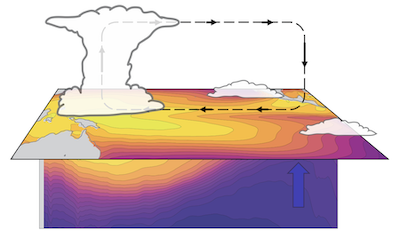
The tropics are characterized by large variations in rainfall seasonally, interannually, and from one region to another, with these spatiotemporal variations governing the water availability for more than half of the world’s population. Tropical rainfall variations are tightly coupled to the atmospheric circulation, which transports water that is evaporated in one region and deposits it as precipitation in another, for example leading to rainfall bands such as the Intertropical Convergence Zone (ITCZ) in regions of lower-tropospheric convergence. As the climate warms, the atmosphere can hold more water vapor, increasing the contrast between wet regions and dry regions and between wet periods and dry periods. However, changes in the atmospheric circulation can modify which regions are wet and which are dry or modulate the strengthening of rainfall contrasts. Our past work has shown that an overall weakening of tropical circulations makes the spatial variability of tropical rainfall increase less quickly than would be expected from the increase in atmospheric moisture content and used a simplified model of the global atmosphere to understand how this weakening of tropical circulations comes about from the thermal expansion of the troposphere.
The dynamics of tropical circulation changes and their influence on rainfall are core to several ongoing projects in the group, spanning multiple timescales and regions. Find out more here. Overall, our focus on tropical dynamics and rainfall supports our group’s mission to contribute to improving regional climate projections, in particular concerning how water resources might change in the future.
Relevant publications:
Kroll, C.A., R.C. Jnglin Wills, L. Kornblueh, U. Niemeier, and A. Schneidereit, 2025: Parameterization adaption needed to unlock the benefits of increased resolution for the ITCZ in ICON, Atmospheric Chemistry and Physics, 25 (22), 16915–16943. [PDF] [Official Version]
Fahrenbach, N.L.S., R.C.J. Wills, and S.J. De Hertog, 2025: Mechanistic insights into tropical circulation and hydroclimate responses to future forest cover change, Weather and Climate Dynamics, 6 (4), 1461–1477. [PDF] [SI] [Official Version]
Wills, R.C.J., Y. Dong, C. Proistosescu, K.C. Armour, and D.S. Battisti, 2022: Systematic climate model biases in the large-scale patterns of recent sea-surface temperature and sea-level pressure change. Geophysical Research Letters, 49. [PDF] [SI] [Official Version] [UW News] [Presentation in SMILE Webinar, July 2022]
Wills, R.C., X.J. Levine, and T. Schneider, 2017: Local energetic constraints on Walker circulation strength. Journal of the Atmospheric Sciences, 74, 1907–1922. [PDF] [Official version]
Corrigendum. Journal of the Atmospheric Sciences, 76, 3965. [Corrigendum]
Wills, R.C., M.P. Byrne, and T. Schneider, 2016: Thermodynamic and dynamic controls on changes in the zonally anomalous hydrological cycle. Geophysical Research Letters, 43, 4640–4649. [PDF] [SI] [Official version] [EOS Spotlight]
Wills, R.C. and T. Schneider, 2016: How stationary eddies shape changes in the hydrological cycle: Zonally asymmetric experiments in an idealized GCM. Journal of Climate, 29, 3161–3179. [PDF] [Official version]
Wills, R.C. and T. Schneider, 2015: Stationary eddies and the zonal asymmetry of net precipitation and ocean freshwater forcing. Journal of Climate, 28, 5115-5133. [PDF] [Official version]
Corrigendum. Journal of Climate, 30, 8841–8842. [Corrigendum]
The Pattern of Climate Change

As the Earth warms due to anthropogenic emissions, some regions warm more than others. This includes well-known and understood phenomena such as polar amplified warming and enhanced warming over land. However, how the pattern of sea-surface temperatures (SSTs) will change is more uncertain. One reason for this uncertainty is that the pattern of SST change observed over the past 40-60 years is quite different from what most climate models project would happen due to anthropogenic forcing over this time period, with more warming in the West Pacific and Indian Ocean but less warming or even regional cooling in parts of the East Pacific. In contrast, models suggest that the East Pacific should be a region of amplified warming, and our work has shown that models are unable to reproduce the observed SST trend pattern, even when accounting for decadal climate variability. The discrepancy in the recent warming pattern between models and observations has strengthened the Walker circulation and modified regional climate around the Pacific basin, and it has also reduced the effective climate sensitivity and global warming rate over this time period by increasing low-cloud cover. Our group’s ongoing research aims to understand the contributions of greenhouse-gas, anthropogenic-aerosol, and volcanic forcing and internal variability to observed SST pattern trends and to understand how climate models can be improved to better capture these trends. Find out more here.
Relevant publications:
Wills, R.C.J., C. Deser, K.A. McKinnon, A. Phillips, S. Po-Chedley, S. Sippel, A.L. Merrifield, C. Bône, C. Bonfils, G. Camps-Valls, S. Cropper, C. Connolly, S. Duan, H. Durand, A. Feigin, M.A. Fernandez, G. Gastineau, A. Gavrilov, E. Gordon, M. Günther, M. Höver, S. Kravtsov, Y.-N. Kuo, J. Lien, G.D. Madakumbra, N. Mankovich, M. Newman, J. Rader, J.-R. Shi, S.-I. Shin, G. Varando: Forced Component Estimation Statistical Method Intercomparison Project (ForceSMIP), submitted to Journal of Climate. [Preprint]
Simpson*, I.R., T.A. Shaw*, P.A. Ceppi, A.C. Clement, E. Fischer, K.M. Grise, A.G. Pendergrass, J.A. Screen, R.C.J. Wills, T. Woollings, R. Blackport, J.M. Kang, and S. Po-Chedley, 2025: Confronting Earth system model trends with observations, Science Advances, 11. [PDF] [Official Version]
Armour, K.C., C. Proistosescu, Y. Dong, L.C. Hahn, E. Blanchard-Wrigglesworth, A.G. Pauling, R.C. Jnglin Wills, T. Andrews, M.F. Stuecker, S. Po-Chedley, I. Mitevski, P.M. Forster, and J.M. Gregory, 2024: Sea-surface temperature pattern effects have slowed global warming and biased warming-based constraints on climate sensitivity. Proceedings of the National Academy of Sciences, 121 (12) e231209312. [Official Version]
Bonan, D.B., J.S. Dörr, R.C.J. Wills, A.F. Thompson, and M. Årthun, 2024: Sources of low-frequency variability in observed Antarctic sea ice. The Cryosphere, 18, 2141–2159. [PDF] [Official Version]
Dörr, J.S., D.B. Bonan, M. Årthun, L. Svendsen, and R.C.J. Wills, 2023: Forced and internal components of observed Arctic sea-ice changes. The Cryosphere, 17, 4133–4153. [PDF] [Official Version]
Maher, N., R.C. Jnglin Wills, P. DiNezio, J. Klavans, S. Milinski, S.C. Sanchez, S. Stevenson, M.F. Stuecker, and X. Wu, 2023: The future of the El Niño-Southern Oscillation: Using large ensembles to illuminate time-varying responses and inter-model differences. Earth System Dynamics, 14, 413–431. [PDF] [SI] [Official Version]
Wills, R.C.J., Y. Dong, C. Proistosescu, K.C. Armour, and D.S. Battisti, 2022: Systematic climate model biases in the large-scale patterns of recent sea-surface temperature and sea-level pressure change. Geophysical Research Letters, 49. [PDF] [SI] [Official Version] [UW News] [Presentation in SMILE Webinar, July 2022]
Wills, R.C.J., K.C. Armour, D.S. Battisti, C. Proistosescu, and L.A. Parsons, 2021: Slow modes of global temperature variability and their impact on climate sensitivity estimates. Journal of Climate, 34, 8717–8738. [PDF] [Official Version] [Corrigendum] [Presentation in ECS and Cloud Feedback symposium, April 2022]
Wills, R.C.J., D.S. Battisti, K.C. Armour, T. Schneider, and C. Deser, 2020: Pattern recognition methods to separate forced responses from internal variability in climate model ensembles and observations. Journal of Climate, 33, 8693–8719. [PDF] [SI] [Official Version] [PCC Research Highlight]
Wills, R.C., T. Schneider, J.M. Wallace, D.S. Battisti, and D.L. Hartmann, 2018: Disentangling global warming, multidecadal variability, and El Niño in Pacific temperatures. Geophysical Research Letters, 45, 2487–2496. [PDF] [SI] [Official version] [Code] [Science Editor's Note] [PCC Research Highlight]
Wills, R.C., X.J. Levine, and T. Schneider, 2017: Local energetic constraints on Walker circulation strength. Journal of the Atmospheric Sciences, 74, 1907–1922. [PDF] [Official version]
Corrigendum. Journal of the Atmospheric Sciences, 76, 3965. [Corrigendum]
Atmospheric Circulation Variability and Change

Uncertainty in future changes in regional climate arises primarily from uncertain changes in the large-scale atmospheric circulation, which redistributes heat, moisture, and atmospheric tracers around the globe. Understanding of changes in the atmospheric circulation lags behind understanding of climate changes that are directly related to temperature, because atmospheric circulations have large variability that makes robust assessments of trends difficult and because atmospheric circulations are governed by complex dynamics that span scales ranging from microscopic to global and involve coupling with all other components of the Earth system. Confidence in projected circulation changes can be gained by showing their robustness across different climate models that employ different empirical treatments of small-scale processes and by understanding the physical mechanisms governing these robust circulation changes.
Our work focuses on evaluating projected changes in atmospheric circulations that are relevant for regional climate impacts, such as stationary waves, monsoonal circulations, and extratropical cyclones, and understanding the physical mechanisms underlying these changes. Much of what is known about changes in these circulations as well as open questions that remain are reviewed in Wills et al. 2019 . Our past work has shown that moist processes and the vertical structure of the atmosphere are important factors determining how circulations respond to climate change and this continues to be a focus of our work. In addition to understanding changes in the seasonal-mean circulations, there is a need to understand changes in the variability of circulations, which in turn leads to variability in rainfall and temperature. Find out more here.
Relevant publications:
Simpson*, I.R., T.A. Shaw*, P.A. Ceppi, A.C. Clement, E. Fischer, K.M. Grise, A.G. Pendergrass, J.A. Screen, R.C.J. Wills, T. Woollings, R. Blackport, J.M. Kang, and S. Po-Chedley, 2025: Confronting Earth system model trends with observations, Science Advances, 11. [PDF] [Official Version]
Wills, R.C.J., Y. Dong, C. Proistosescu, K.C. Armour, and D.S. Battisti, 2022: Systematic climate model biases in the large-scale patterns of recent sea-surface temperature and sea-level pressure change. Geophysical Research Letters, 49. [PDF] [SI] [Official Version] [UW News] [Presentation in SMILE Webinar, July 2022]
Wills, R.C.J., R.H. White, and X.J. Levine, 2019: Northern Hemisphere stationary waves in a changing climate, Current Climate Change Reports. [PDF] [SI] [Official version]
Wills, R.C.J. and T. Schneider, 2018: Mechanisms setting the strength of orographic Rossby waves across a wide range of climates in a moist idealized GCM. Journal of Climate, 31, 7679–7700. [PDF] [Official version]
Wills, R.C., X.J. Levine, and T. Schneider, 2017: Local energetic constraints on Walker circulation strength. Journal of the Atmospheric Sciences, 74, 1907–1922. [PDF] [Official version]
Corrigendum. Journal of the Atmospheric Sciences, 76, 3965. [Corrigendum]
Wills, R.C. and T. Schneider, 2016: How stationary eddies shape changes in the hydrological cycle: Zonally asymmetric experiments in an idealized GCM. Journal of Climate, 29, 3161–3179. [PDF] [Official version]
Decadal Atmosphere-Ocean Variability
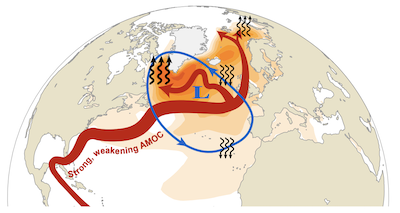
Unforced climate variability on decadal and longer time scales is of interest both because of its potential predictability and because it is a source of noise that makes it difficult to determine the regional impacts of anthropogenic climate change. Our research focuses on identifying patterns of sea-surface temperature (SST) variability that are associated with low-frequency climate variability in the world’s ocean and understanding their mechanisms and impacts. Our work has provided insight into the role of ocean circulation in maintaining persistent SST anomalies, the relative role of air-sea fluxes of heat and momentum in ocean circulation dynamics, and the feedback of persistent SST anomalies onto the atmospheric circulation.
Our work on Pacific climate variability has shown that the decadal variability of Pacific SSTs is more independent of El Niño than previously thought, has improved our ability to separate the signals of global warming, the Pacific Decadal Oscillation (PDO), and El Niño in observations, and has established the role of the North Pacific subpolar gyre variability in the PDO. Our work on Atlantic climate variability has improved the mechanistic understanding of the Atlantic Multidecadal Oscillation (AMO), which results from the two-way interactions between the Atlantic Meridional Overturning Circulation (AMOC) and the overlying atmosphere. Our work has also helped to quantify the impacts of different modes of variability on Earth's energy budget and global-mean surface temperature.
One major outstanding question about decadal atmosphere-ocean variability is about the extent to which midlatitude SST anomalies impact the atmospheric circulation. This impact of ocean anomalies on the atmospheric circulation is key to determining how predictable regional climate anomalies are on decadal timescales. Our work has shown that the impact of midlatitude SST anomalies on the atmospheric circulation is larger at higher resolution, and ongoing work in the group focuses on understanding the mechanisms of this larger response at higher resolution and the consequences of the larger response for decadal climate prediction. Find out more here.
Relevant publications:
Wills, R.C.J., A. R. Herrington, I.R. Simpson, D.S. Battisti, 2024: Resolving weather fronts increases the large-scale circulation response to Gulf Stream SST anomalies in variable-resolution CESM2 simulations. Journal of Advances in Modeling Earth Systems, 16, e2023MS004123. [PDF] [SI] [Official Version] [Editor's Highlight]
Bonan, D.B., J.S. Dörr, R.C.J. Wills, A.F. Thompson, and M. Årthun, 2024: Sources of low-frequency variability in observed Antarctic sea ice. The Cryosphere, 18, 2141–2159. [PDF] [Official Version]
Dörr, J.S., D.B. Bonan, M. Årthun, L. Svendsen, and R.C.J. Wills, 2023: Forced and internal components of observed Arctic sea-ice changes. The Cryosphere, 17, 4133–4153. [PDF] [Official Version]
Maher, N., R.C. Jnglin Wills, P. DiNezio, J. Klavans, S. Milinski, S.C. Sanchez, S. Stevenson, M.F. Stuecker, and X. Wu, 2023: The future of the El Niño-Southern Oscillation: Using large ensembles to illuminate time-varying responses and inter-model differences. Earth System Dynamics, 14, 413–431. [PDF] [SI] [Official Version]
Shi, H., F.-F. Jin, R.C.J. Wills, M.G. Jacox, B.A. Black, D.J. Amaya, R. R. Rykaczewski, S.J. Bograd, M. García-Reyes, and W.J. Sydeman, 2022: Global decline in ocean memory over the 21st century. Science Advances, 8. [PDF] [SI] [Official Version] [Press Release] [EurekAlert] [Nature Research Highlight] [EOS]
Oldenburg, D., R.C.J. Wills, K.C. Armour, L. Thompson, 2022: Resolution dependence of atmosphere-ocean interactions and water-mass transformation in the North Atlantic. Journal of Geophysical Research: Oceans, 127. [PDF] [SI] [Official Version]
Wills, R.C.J., K.C. Armour, D.S. Battisti, C. Proistosescu, and L.A. Parsons, 2021: Slow modes of global temperature variability and their impact on climate sensitivity estimates. Journal of Climate, 34, 8717–8738. [PDF] [Official Version] [Corrigendum] [Presentation in ECS and Cloud Feedback symposium, April 2022]
Oldenburg D., R.C.J. Wills, K.C. Armour, L. Thompson, and L.C. Jackson, 2021: Mechanisms of low-frequency variability in Atlantic northward ocean heat transport and AMOC. Journal of Climate, 34, 4733–4755. [PDF] [Official Version]
Årthun, M., R.C.J. Wills, H. Johnson, L. Chafik, and H.R. Langehaug, 2021: Mechanisms of decadal North Atlantic climate variability and implications for the recent cold anomaly. Journal of Climate, 34, 3421–3439. [PDF] [SI] [Official Version]
Parsons, L.A., M.K. Brennan, R.C.J. Wills, and C. Proistosescu, 2020: Magnitudes and spatial patterns of interdecadal temperature variability in CMIP6. Geophysical Research Letters, 47. [PDF] [SI] [Official Version]
Wills, R.C.J., D.S. Battisti, C. Proistosescu, L. Thompson, D.L. Hartmann, and K.C. Armour, 2019: Ocean circulation signatures of North Pacific decadal variability. Geophysical Research Letters, 46, 1690–1701. [PDF] [SI] [Official version] [Presentation at AMS-AOFD, June 2019]
Wills, R.C.J., K.C. Armour, D.S. Battisti, and D.L. Hartmann, 2019: Ocean-atmosphere dynamical coupling fundamental to the Atlantic Multidecadal Oscillation. Journal of Climate, 32, 251–272. [PDF] [Official version]
Wills, R.C., T. Schneider, J.M. Wallace, D.S. Battisti, and D.L. Hartmann, 2018: Disentangling global warming, multidecadal variability, and El Niño in Pacific temperatures. Geophysical Research Letters, 45, 2487–2496. [PDF] [SI] [Official version] [Code] [Science Editor's Note] [PCC Research Highlight]
High-Resolution Climate Modeling
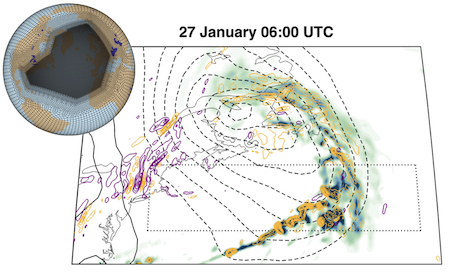
Much of the uncertainty in climate projections stems from the need to empirically parameterize processes on scales smaller than can be resolved explicitly in global climate models, such as clouds, convection, and turbulence. Recent advances in computational resources and modeling now allow simulations at higher resolutions than were previously possible, such that mesoscale processes (at horizonal scales of 10-100 km) can be represented in global models. These new high-resolution models provide an unprecedented opportunity to understand the two-way interactions between mesoscale processes, which are important in the dynamics of weather systems, and the large-scale climate system. Our research uses a hierarchical modeling approach across a range of resolutions and configurations in the CESM and ICON climate models to understand (1) the role of frontal processes in atmosphere-ocean coupling in midlatitudes and the potential for improved climate predictions from higher resolution models that resolve these processes and (2) differences in tropical climate and its response to external forcings between high-resolution configurations with resolved deep convection and coarse-resolution configurations with parameterized deep convection. Our overarching goals are both to understand the fundamental dynamics of cross-scale interactions between the mesoscale and global scale and to develop new modeling and machine learning methods to bring the added value of representing mesoscale processes into coarse-resolution global models, which are still needed to broadly investigate climate change scenarios.
Relevant publications:
Kroll, C.A., C. Schär, A. Dipankar, and R.C.J. Wills: Enhancing the upper boundary layer damping scheme for km-scale ICON: A question of wavelength, submitted to Journal of Advances in Modeling Earth Systems. [Preprint]
Kroll, C.A., R.C. Jnglin Wills, L. Kornblueh, U. Niemeier, and A. Schneidereit, 2025: Parameterization adaption needed to unlock the benefits of increased resolution for the ITCZ in ICON, Atmospheric Chemistry and Physics, 25 (22), 16915–16943. [PDF] [Official Version]
Sun, L., R.C.J. Wills, C. Deser, A. Herrington, I.R. Simpson, and M. Gervais: Increased model resolution amplifies Arctic precipitation and atmospheric circulation response to sea-ice loss, submitted to Journal of Climate. [Preprint]
Wills, R.C.J., A.R. Herrington, I.R. Simpson, D.S. Battisti, 2024: Resolving weather fronts increases the large-scale circulation response to Gulf Stream SST anomalies in variable-resolution CESM2 simulations. Journal of Advances in Modeling Earth Systems, 16, e2023MS004123. [PDF] [SI] [Official Version] [Editor's Highlight] [Presentation at EXCLAIM Symposium, June 2025]
Schneider, T., L.R. Leung, and R.C.J. Wills, 2024: Opinion: Optimizing climate models with process-knowledge, resolution, and AI. Atmospheric Chemistry and Physics (ACP), 24, 7041–7062. [PDF] [Official Version]
Oldenburg, D., R.C.J. Wills, K.C. Armour, L. Thompson, 2022: Resolution dependence of atmosphere-ocean interactions and water-mass transformation in the North Atlantic. Journal of Geophysical Research: Oceans, 127. [PDF] [SI] [Official Version]
Climate Data Science
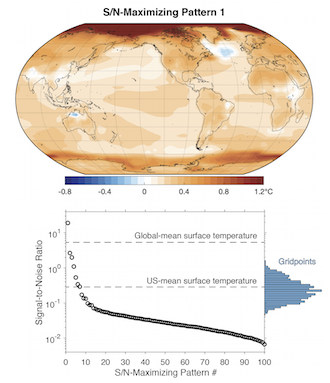
Separating the forced and unforced components of climate change is critical challenge in climate science, as it is a necessary step in understanding the causes of observed changes and in improving projections of future changes in regional climate. We develop and use pattern recognition methods to distinguish between forced and unforced components of global climate changes. In particular, our work has led to the development of low-frequency component analysis (LFCA), a specific case of linear discriminant analysis for isolating slow variations in spatiotemporal data, as well as a number of new applications of signal-to-noise maximizing pattern (S/NP) analysis.
In Wills et al. 2020 , we show that pattern recognition methods such as LFCA and S/NP analysis help to separate the forced and unforced components of climate change with up to ten times fewer ensemble members than traditional methods, with LFCA even allowing an approximation of the forced and unforced components of observed changes. This helps to evaluate climate models against observations by first removing known modes of variablity such as El Niño from observations, for example showing that observed temperatures in the eastern tropical Pacific have increased less than in other parts of the tropics, a result that is not easily reproduced in climate models. Similarly, application of these methods to observations have been used to understand contributions to observed sea-ice variability and change. These pattern recognition methods also help identify hard to detect climate responses within climate models, such as changes in the jet stream over the North Atlantic and a reduction in rainfall over the U.S. Southwest in the years following tropical volcanic eruptions.
We are now co-organizing (together will collaborators at NCAR, UCLA, LLNL, and the University of Leipzig) a large community effort called the Forced Component Estimation Statistical Method Intercomparison Project (ForceSMIP), which aims to evaluate (using large ensembles of climate models) many different types of methods for estimating the forced climate response from individual realizations, including both novel machine learning methods and simple linear methods, and then to apply these methods to observations.
Relevant publications:
Wills, R.C.J., C. Deser, K.A. McKinnon, A. Phillips, S. Po-Chedley, S. Sippel, A.L. Merrifield, C. Bône, C. Bonfils, G. Camps-Valls, S. Cropper, C. Connolly, S. Duan, H. Durand, A. Feigin, M.A. Fernandez, G. Gastineau, A. Gavrilov, E. Gordon, M. Günther, M. Höver, S. Kravtsov, Y.-N. Kuo, J. Lien, G.D. Madakumbra, N. Mankovich, M. Newman, J. Rader, J.-R. Shi, S.-I. Shin, G. Varando: Forced Component Estimation Statistical Method Intercomparison Project (ForceSMIP), submitted to Journal of Climate. [Preprint]
Bonan, D.B., J.S. Dörr, R.C.J. Wills, A.F. Thompson, and M. Årthun, 2024: Sources of low-frequency variability in observed Antarctic sea ice. The Cryosphere, 18, 2141–2159. [PDF] [Official Version]
Dörr, J.S., D.B. Bonan, M. Årthun, L. Svendsen, and R.C.J. Wills, 2023: Forced and internal components of observed Arctic sea-ice changes. The Cryosphere, 17, 4133–4153. [PDF] [Official Version]
Bonan, D.B., T. Schneider, I. Eisenman, and R.C.J. Wills, 2021: Constraining the date of a seasonally ice-free Arctic using a simple model. Geophysical Research Letters, 48. [PDF] [SI] [Official Version] [PCC Research Highlight] [Polar Bears International]
Wills, R.C.J., D.S. Battisti, K.C. Armour, T. Schneider, and C. Deser, 2020: Pattern recognition methods to separate forced responses from internal variability in climate model ensembles and observations. Journal of Climate, 33, 8693–8719. [PDF] [SI] [Official Version] [PCC Research Highlight]
Wills, R.C.J., S. Sippel, and E. A. Barnes, 2020: Separating forced and unforced components of climate change: The utility of pattern recognition methods in large ensembles and observations. US CLIVAR Variations, 18, 1–10, Not Peer Reviewed. [PDF] [Official version] [Webinar Presentation, September 2020]
Wills, R.C.J., K.C. Armour, D.S. Battisti, and D.L. Hartmann, 2019: Ocean-atmosphere dynamical coupling fundamental to the Atlantic Multidecadal Oscillation. Journal of Climate, 32, 251–272. [PDF] [Official version]
Wills, R.C., T. Schneider, J.M. Wallace, D.S. Battisti, and D.L. Hartmann, 2018: Disentangling global warming, multidecadal variability, and El Niño in Pacific temperatures. Geophysical Research Letters, 45, 2487–2496. [PDF] [SI] [Official version] [Code] [Science Editor's Note] [PCC Research Highlight]
Wills, R.C., D.S. Battisti, D.L. Hartmann, and T. Schneider, 2017: Extracting modes of variability and change from climate model ensembles. Proceedings of the 7th International Workshop on Climate Informatics: CI 2017, V. Lyubchich, N.C. Oza, A. Rhines, and E. Szekely, Eds., NCAR Technical Note NCAR/TN-536+PROC, 25–28. [PDF] [Official version]
Past Atmosphere and Ocean Changes
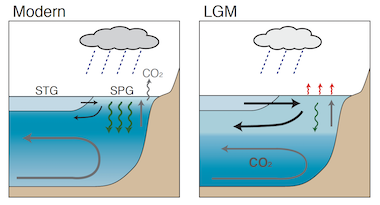
The atmosphere exerts a fundamental influence on the ocean circulation through surface fluxes of freshwater, heat, and momentum. For example, the absence of deep-water formation and meridional overturning in the modern North Pacific results in part from an excess of precipitation over evaporation due to atmospheric moisture flux convergence. We are interested in how the ocean circulation differed in past climates, in understanding how these changes are related to differences in atmospheric forcing, and in developing a mechanistic understanding of large-scale asymmetries in the global ocean circulation.
Our work has focused in particular on changes in the North Pacific ocean circulation over the last 21,000 years. We have found climate model and sediment-core-based proxy evidence that at the Last Glacial Maximum (LGM), 21,000 years ago, the jet stream was further south and the Aleutian Low was stronger than in the present climate, due in part to the stationary waves forced by the Laurentide Ice Sheet over North America. Model evidence suggests that this led to a stronger and larger North Pacific subpolar gyre circulation. These atmospheric and oceanic changes made the North Pacific less stratified and allowed for stronger ventilation down to intermediate depths, potentially even allowing North Pacific deep-water formation during stadial events. Using a similar combination of model and proxy evidence, our work has shown that the Southern Hemisphere westerlies were further equatorward at the LGM, which allowed for greater carbon storage in the deep ocean.
Relevant publications:
Gray, W.R., C. deLavergne, R.C. Jnglin Wills, L. Menviel, P. Spence, M. Holzer, M. Kageyama, and E. Michel, 2023: Poleward shift in the Southern Hemisphere westerly winds synchronous with the deglacial rise in CO2. Paleoceanography and Paleoclimatology, 38. [PDF] [SI] [Official Version]
Nilsson, J., D. Ferreira, T. Schneider, and R.C.J. Wills, 2021: Is the surface salinity difference between the Atlantic and Indo-Pacific a signature of the Atlantic Meridional Overturning Circulation? Journal of Physical Oceanography, 51, 769–787. [PDF] [Official Version]
Rae, J.W.B., W.R Gray, R.C.J. Wills, I. Eisenman, B. Fitzhugh, E.F.M. Littley, P. Rafter, R. Rees-Owen, A. Ridgwell, B. Taylor, and A. Burke, 2020: Overturning circulation, nutrient limitation, and warming in the glacial North Pacific. Science Advances, 6. [PDF] [SI] [Official Version] [UW News]
Gray, W.R., R.C.J. Wills, J.W.B. Rae, A. Burke, R. Ivanovic, W.H.G. Roberts, D. Ferreira, and P.J. Valdes, 2020: Wind-driven evolution of the North Pacific subpolar gyre over the last deglaciation. Geophysical Research Letters, 47. [PDF] [SI] [Official Version]
Gray, W.R., J.W.B. Rae, R.C.J. Wills, A.E. Shevenell, G.L. Foster, C.H. Lear, and B. Taylor, 2018: Deglacial upwelling, productivity and CO2 outgassing in the North Pacific Ocean. Nature Geoscience, 11, 340–344. [Official version] [News and Views]
Ferreira, D., P. Cessi, H. Coxall, A. de Boer, H.A. Dijkstra, S.S. Drijfhout, T. Eldevik, N. Harnik, J.F. McManus, D.P. Marshall, J. Nilsson, F. Roquet, T. Schneider, R.C. Wills, 2018: Atlantic-Pacific asymmetry in deep water formation. Annual Reviews of Earth and Planetary Sciences, 46, 327–352. [Official version]
| |